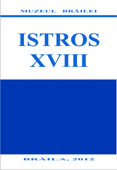Foreign merchants in Iaşi (17th–18th centuries)
Foreign merchants in Iaşi (17th–18th centuries)
Author(s): Laurenţiu RădvanSubject(s): History
Published by: Editura Istros - Muzeul Brailei
Keywords: merchants; craftsmen; foreigners; urban society; Greeks; Moldavia.
Summary/Abstract: The present study focus on the presence of foreign merchants in Iasi in the 17th–18th centuries. We have chosen this category since it was one of the most present in towns, and was also – owing to the specifics of the trade – well-represented in the sources of the time, as well as very mobile. It included both commoners, who were engaged in small trade, stable or travelling, and members of the well-to-do, who “moved” large amounts of money, owned land in towns, and even domains in the countryside (some even hoped to become boyars), conducted business in the country and abroad etc. In the 17th century, Iaşi had become the capital of Moldavia, the largest and most dynamic town in the country, and it became very appealing to some foreigners who sought to make a living here. Religion and ethnicity played their part in Moldavian urban society, with the communities of townspeople including members of various religious origins and faiths: Orthodox Romanians, Greeks, Serbs, and Bulgarians, Catholic or Protestant Germans and Hungarians, Armenians, Jews etc. The present study will focus more on occupation and ethnicity. In the 16th century, as the religious Reform unravelled, the number of Germans and Hungarians decreased; however, owing to the close connections with the Ottoman Empire, the number of those Oriental in origin increased: Greeks, Vlachs, Albanians, Turks or Jews. All Moldavian towns, and Iaşi in particular, were a true magnet for all kinds of foreigners, who were drawn here mainly for economic reasons (there are of course individual cases, of people leaving their homeland for religious reasons). Many of them are naturalized in Moldavia. They marry (if they weren’t already) and enter the local families, amass wealth, buy and sell houses, stores or land, make donations, behaving just like other townspeople. The wealthy and the influential obtain positions in guilds, while other seek to become boyars. The world of the Moldavian town in the two centuries which came under our attention was a motley one, with locals and foreigners (who will become locals after several generations), with wealthy and poor, with merchants, craftsmen, but also boyars, servants, and soldiers. The ruler dominated this entire picture, an authoritarian figure which tried to bring order to this world, but also to profit from it.
Journal: ISTROS
- Issue Year: 18/2012
- Issue No: 1
- Page Range: 453-480
- Page Count: 22
- Language: English
- Content File-PDF

